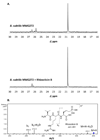Biosynthesis of rhizocticins, antifungal phosphonate oligopeptides produced by Bacillus subtilis ATCC6633
- PMID: 20142038
- PMCID: PMC2819989
- DOI: 10.1016/j.chembiol.2009.11.017
Biosynthesis of rhizocticins, antifungal phosphonate oligopeptides produced by Bacillus subtilis ATCC6633
Abstract
Rhizocticins are phosphonate oligopeptide antibiotics containing the C-terminal nonproteinogenic amino acid (Z)-l-2-amino-5-phosphono-3-pentenoic acid (APPA). Here we report the identification and characterization of the rhizocticin biosynthetic gene cluster (rhi) in Bacillus subtilis ATCC6633. Rhizocticin B was heterologously produced in the nonproducer strain Bacillus subtilis 168. A biosynthetic pathway is proposed on the basis of bioinformatics analysis of the rhi genes. One of the steps during the biosynthesis of APPA is an unusual aldol reaction between phosphonoacetaldehyde and oxaloacetate catalyzed by an aldolase homolog RhiG. Recombinant RhiG was prepared, and the product of an in vitro enzymatic conversion was characterized. Access to this intermediate allows for biochemical characterization of subsequent steps in the pathway.
Copyright (c) 2010 Elsevier Ltd. All rights reserved.
Figures






Similar articles
-
Molecular Basis of Bacillus subtilis ATCC 6633 Self-Resistance to the Phosphono-oligopeptide Antibiotic Rhizocticin.ACS Chem Biol. 2019 Apr 19;14(4):742-750. doi: 10.1021/acschembio.9b00030. Epub 2019 Mar 13. ACS Chem Biol. 2019. PMID: 30830751 Free PMC article.
-
Rhizocticin A, an antifungal phosphono-oligopeptide of Bacillus subtilis ATCC 6633: biological properties.Arch Microbiol. 1990;153(3):276-81. doi: 10.1007/BF00249082. Arch Microbiol. 1990. PMID: 2110446
-
Molecular cloning and heterologous expression of the dehydrophos biosynthetic gene cluster.Chem Biol. 2010 Apr 23;17(4):402-11. doi: 10.1016/j.chembiol.2010.03.007. Chem Biol. 2010. PMID: 20416511 Free PMC article.
-
[Novel L-amino acid ligases catalyzing oligopeptide synthesis].Yakugaku Zasshi. 2010 Nov;130(11):1463-9. doi: 10.1248/yakushi.130.1463. Yakugaku Zasshi. 2010. PMID: 21048404 Review. Japanese.
-
Transporters involved in uptake of di- and tricarboxylates in Bacillus subtilis.Antonie Van Leeuwenhoek. 2003;84(1):69-80. doi: 10.1023/a:1024445131925. Antonie Van Leeuwenhoek. 2003. PMID: 12906362 Review.
Cited by
-
Biosynthesis of fosfazinomycin is a convergent process.Chem Sci. 2015 Feb 1;6(2):1282-1287. doi: 10.1039/C4SC03095H. Chem Sci. 2015. PMID: 25621145 Free PMC article.
-
Use of the dehydrophos biosynthetic enzymes to prepare antimicrobial analogs of alaphosphin.Org Biomol Chem. 2019 Jan 23;17(4):822-829. doi: 10.1039/c8ob02860e. Org Biomol Chem. 2019. PMID: 30608108 Free PMC article.
-
Stereochemistry of Hydride Transfer by Group III Alcohol Dehydrogenases Involved in Phosphonate Biosynthesis.Medchemcomm. 2012 Aug;3(8):967-970. doi: 10.1039/C2MD20009K. Medchemcomm. 2012. PMID: 25400901 Free PMC article. No abstract available.
-
Discovery of phosphonic acid natural products by mining the genomes of 10,000 actinomycetes.Proc Natl Acad Sci U S A. 2015 Sep 29;112(39):12175-80. doi: 10.1073/pnas.1500873112. Epub 2015 Aug 31. Proc Natl Acad Sci U S A. 2015. PMID: 26324907 Free PMC article.
-
Synthesis of methylphosphonic acid by marine microbes: a source for methane in the aerobic ocean.Science. 2012 Aug 31;337(6098):1104-7. doi: 10.1126/science.1219875. Science. 2012. PMID: 22936780 Free PMC article.
References
Publication types
MeSH terms
Substances
Associated data
- Actions
Grants and funding
LinkOut - more resources
Full Text Sources
Other Literature Sources
Molecular Biology Databases

